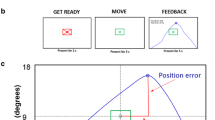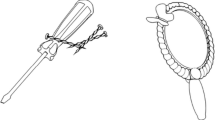Abstract
Performance of homosexual and heterosexual men and women on two motor tasks which reliably demonstrate sex differences in opposite directions was examined. A Throw-to-Target Task and the Purdue Pegboard were administered to undergraduate students matched for age and program of study. A two-way ANOVA (Sex × Sexual Orientation) of the Throw data showed a significant interaction,F(1, 90) = 16.22,p ≤ 0.001, and a trend for an effect of sex,F(1, 90) = 3.72,p < 0.06. Heterosexual men outperformed heterosexual women, whereas gay men threw less accurately and lesbians tended to throw more accurately than their heterosexual counterparts. Differences in sports history or hand strength did not account for these effects. Analysis of the Pegboard scores found no interaction or main effect of sexual orientation, but the effect of sex was significant,F(1,63) = 7.01,p ≤ 0.02. Regardless of sexual orientation, women outperformed men and this difference remained significant even when a measure of finger size was partialed out. This study provides new evidence suggesting an association between sexual orientation and motor-performance profiles. As with cognitive tasks, the motor-performance profiles of homosexuals are composites of some male-typical and some female-typical abilities. To the extent that sociological factors have been controlled, the study suggests that both sexual orientation and motor/cognitive predispositions may have early biological contributions.
Similar content being viewed by others
References
Allen, L. S., and Gorski, R. A. (1992). Sexual orientation and the size of the anterior commissure in the human brain.Proc. Natl. Acad. Sci. U.S. 89: 7199–7202.
Brand, T., Kroonen, J., Mos, J., and Slob, K. (1991). Adult partner preference and sexual behavior of male rats affected by perinatal endocrine manipulations.Horm. Behav. 25: 323–341.
Brand, T., and Slob, A. K. (1991). On the organization of partner preference behaviour in female Wistar rats.Physiol. Behav. 49: 459–555.
Dittmann, R. W., Kappes, M. E., and Kappes, M. H. (1992). Sexual behavior in adolescent and adult females with congenital adrenal hyperplasia.Psychoneuroendocrinology 17: 153–170.
Gladue, B. A., Beatty, W. W., Larson, J., and Staton, R. D. (1990). Sexual orientation and spatial ability in men and women.Psychobiology 18: 101–108.
Gladue, B. A., Green, R., and Hellman, R. E. (1984). Neuroendocrine response to estrogen and sexual orientation.Science 225: 1496–1499.
Goy, R. W., and McEwen, B. S. (1980).Sexual Differentiation of the Brain, MIT Press, London, U.K.
Hamer, D., Hu, S., Magnuson, V. L., Hu, N., and Pattatucci, A. M. L. (1993). A linkage between DNA markers on the X chromosome and male sexual orientation.Science 261: 321–327.
Hall, J. A., and Kimura, D. (1992). Homosexuality, cognitive abilities and the organizational hypothesis.Soc. Neurosci. Abstr. (507.17). 18: 1210.
Hendricks, S. E., Graber, B., and Rodriguez-Sierra, J. F. (1989). Neuroendocrine responses to exogenous estrogen: No difference between heterosexual and homosexual men.Psychoneuroendocrinology 14: 177–185.
Jardine, R., and Martin, N. G. (1983). Spatial ability and throwing accuracy.Behav. Genet. 13: 331–340.
Kimura, D. (1973). Manual activity during speaking-2. Left-handers.Neuropsychologia 11: 51–55.
Kimura, D. (1993).Neuromotor Mechanisms in Human Communication, Oxford, New York.
Kinsey, A. C., Pomeroy, W. B., and Martin, C. E. (1948).Sexual Behavior in the Human Male, Philadelphia, PA, W. B. Saunders.
LeVay, S. (1991). A difference in hypothalamic structure between heterosexual and homosexual men.Science 253: 1034–1037.
Lunn, D., and Kimura, D. (1989). Spatial abilities in preschool-aged children (Research Bulletin No. 681). University of Western Ontario, Department of Psychology.
McCormick, C. M., and Witelson, S. F. (1990). Cognitive abilities in lesbians.Soc. Neurosci. Abstr. (509.10). 16: 2.
Meany, M. J., and McEwen, B. S. (1986). Testosterone implants into the amygdala during the neonatal period masculinize the social play of juvenile female rats.Brain Res. 398: 324–328.
Money, J., Schwartz, M., and Lewis, V. G. (1984). Adult erotosexual status and fetal hormonal masculinization and demasculinization: 46, XX congenital virilizing adrenal hyperplasia & 46, XY androgen-insensitivity syndrome compared.Psychoneuroendocrinology 9: 405–414.
Peters, M., Servos, P., and Day, R. (1990). Marked sex differences on a fine motor skill task disappear when finger size is used as a covariate.J. Appl. Psychol. 75: 87–90.
Resnick, S. M., Berenbaum, S. A., Gottesman, I. I., and Bouchard, T. J. (1986). Early hormonal influences on cognitive functioning in congenital adrenal hyperplasia.Dev. Psychol. 22: 191–198.
Sanders, G. (1992). Sexual orientation and cognitive function.Int. J. Psychol. Abstr. (SY068.4). 27: 333.
Sanders, G., and Ross-Field, L. (1986a). Sexual orientation, cognitive abilities and cerebral asymmetry: A review and a hypothesis tested.Ital. J. Zool. 20: 459–470.
Sanders, G., and Ross-Field, L. (1986b). Sexual orientation and visuospatial ability.Brain Cognit. 5: 280–290.
Sanders, G., and Wright, M. (1993, June). Sexual orientation differences in targeted throwing and manual dexterity tasks. Poster presented at the 19th annual meeting of the International Academy for Sex Research.
Swaab, D. F., and Hofman, M. A. (1990). An enlarged suprachiasmatic nucleus in homosexual men.Brain Res. 537: 141–148.
Tiffin, T. (1968).Purdue Pegboard Examiner Manual, Science Research Associates, Chicago.
Tuttle, G. E., and Pillard, R. C. (1991). Sexual orientation and cognitive abilities.Arch. Sex. Behav. 20: 307–318.
Watson, N. V., and Kimura, D. (1991). Nontrivial sex differences in throwing and intercepting: Relation to psychometrically-defined spatial functions.Pers. Indiv. Diff. 12: 375–385.
Williams, C. L., Barnett, A. M., and Meck, W. H. (1990). Organizational effects of early gonadal secretions on sexual differentiation in spatial memory.Behav. Neurosci. 104: 84–97.
Willmott, M., and Brierley, H. (1984). Cognitive characteristics and homosexuality.Arch. Sex. Behav. 13: 311–319.
Author information
Authors and Affiliations
Additional information
This research was supported by a grant from the Medical Research Council, Ottawa, to D. Kimura.
Rights and permissions
About this article
Cite this article
Hall, J.A.Y., Kimura, D. Sexual orientation and performance on sexually dimorphic motor tasks. Arch Sex Behav 24, 395–407 (1995). https://doi.org/10.1007/BF01541855
Issue Date:
DOI: https://doi.org/10.1007/BF01541855




